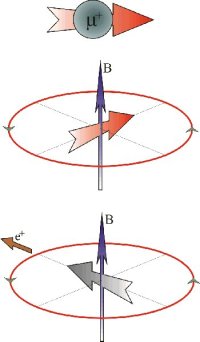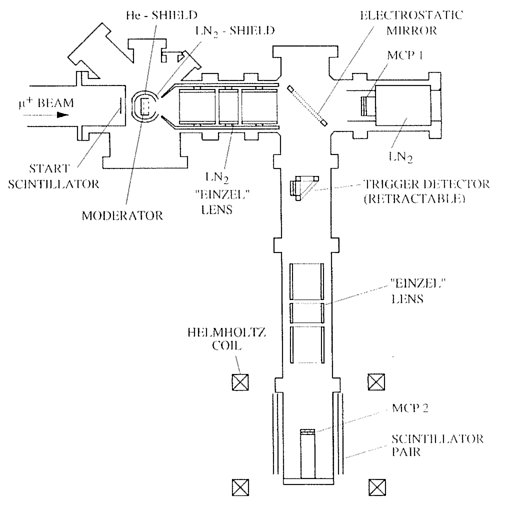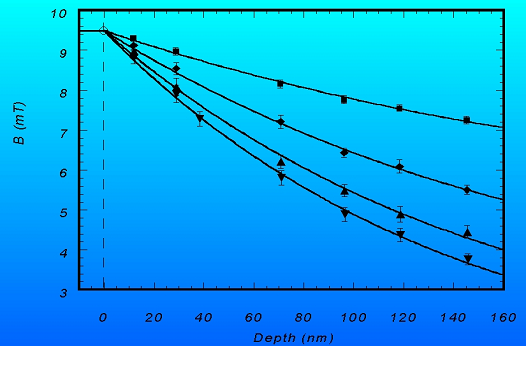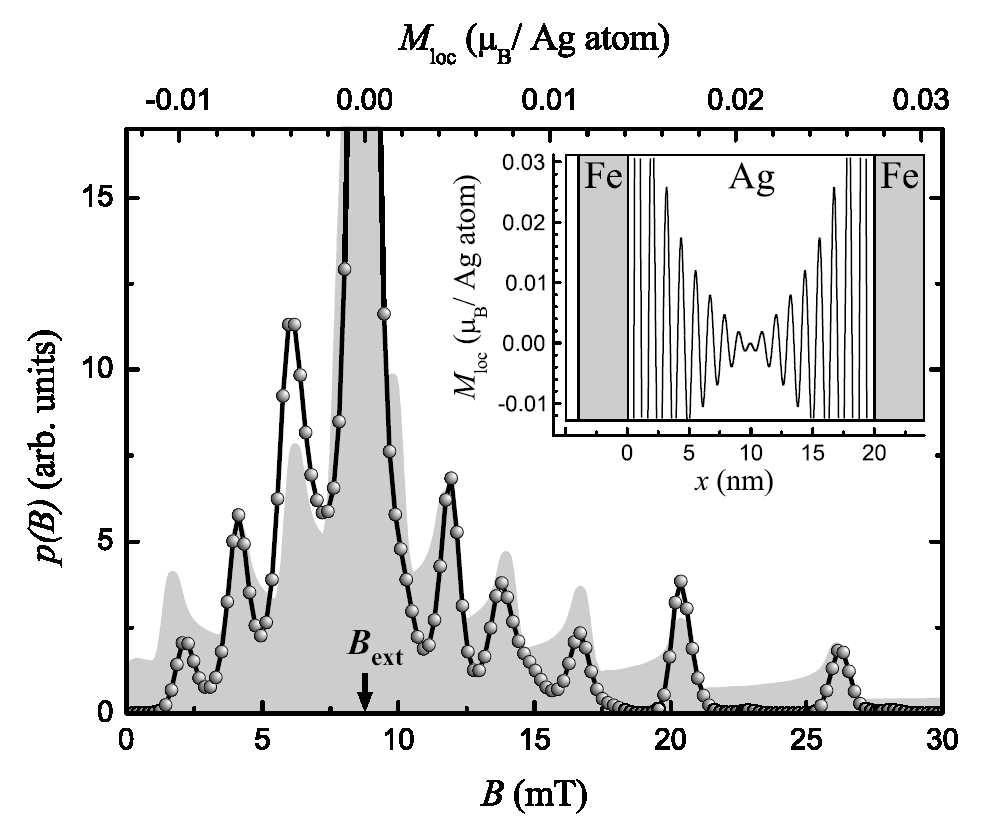Low energy muons in the study of superconductivity and magnetism
Skip to section: | Introduction | muSR instruments | Research |
The muon spin rotation (muSR) sub-group is headed by Professor E.M. Forgan, and involves external collaborations with Silvia Ramos at the Diamond facility, Oxfordshire, Naren H.R. at TIFR, Mumbai and Elvezio Morenzoni at PSI, Switzerland. Our research in this field has resulted in numerous high-profile publications.
Introduction
Muons (μ) are elementary particles of spin , with an average life time of 2.2 μs and can have either positive or negative charge. When implanted in a condensed matter sample, positive muons behave as a very light proton. This means that they will sit at interstitial sites between the atoms of the sample (in the same way as a hydrogen nucleus would). As they are particles with spin , they will feel the magnetic environment around them. In the presence of a magnetic field perpendicular to the initial polarisation of the muons, they will precess at a frequency proportional to the field (Larmor frequency). The frequency of precession of μ+ particles can be measured through the products of their decay. When the μ+ disintegrates, it emits a positron and a neutrino. The positron is mainly emitted in the direction of the spin of the muon at the time of decay. Hence the directions of emission of the positrons as a function of time give the distribution of Larmor frequencies in the sample and from this the probability of finding a certain value of the local magnetic field inside the sample can be obtained. This technique is known as muon spin rotation (μSR) and it is part of a family of spectroscopic techniques that use muons as probes in condensed matter physics. The natural field of application of muon spin rotation is the study of systems where the magnetic properties of the material are interesting: flux lattices in superconductors, ferromagnetic and antiferromagnetic order, systems that exhibit colossal magnetoresistance (CMR), etc.

A schematic representation of a muon in a magnetic field
μSR is generally used to study bulk properties of materials. However, in recent years the study of 2-dimensional physical phenomena (e.g. thin films and surface effects) has become of interest for both fundamental and applied physics. Consequently low energy muon techniques where the implantation depth of the muon can be controlled (typically to 10's of nm) are being developed. Our group is currently involved in this work with special interest in its application to the study of the properties of magnetic and superconducting thin film multilayers.
μSR instruments
Muons are generated as a result of pion decay in accelerator-based large facilities such as ISIS in Chilton (U.K) or the Paul Scherrer Institute (PSI) in Villigen (Switzerland). Both of these sources have instruments devoted to μSR techniques for the study of bulk properties of materials. At ISIS, 3 instruments currently being used for this type of work: EMU, MuSR and Argus (the latter, as part of the Riken facility). At PSI there are 4 instruments available: GPS, LTF, Dolly and ALC.
The use of low energy muons is a much more recent development and there is currently only one instrument in the world where measurements can be carried out. This instrument is called LEM and is part of the Paul Scherrer Institute (PSI). A diagram of the layout of this unique instrument is shown in the figure below. The key aspect of the design is that the energy of the incoming muons (approx. 4 MeV) is moderated by making them pass through a layer of solid Ar or Ne. Out of the moderator come particles with energies in the range of a few eV which will then be accelerated again (to 1-30 keV) to suit the chosen implantation depth into our sample. The energy range covered by the re-accelerated μ+ particles is enough to implant them at depths going from a few nm up to a few hundred. Our work related to the development and application of slow muons as a probe for condensed matter is carried out in collaboration with the staff at PSI together with groups in the Universities of St. Andrews, Zurich (Switzerland) and Konstanz (Germany).

A diagram showing the layout of the LEM instrument
Research
Our group has worked on several research projects in which μSR measurements are a crucial part. These include the study of the flow of flux lines in type-II superconductors in both bulk (μSR) and thin film samples (LE-μSR), the exploration of the unexpectedly rich phase diagram of the flux lattice in s-wave superconductor niobium (μSR) and the study of magnetic properties in the interphase between superconducting, magnetic and non-magnetic multilayers (LE-μSR). Below there are some examples of ground-breaking initial work carried out in these fields.
Measurement of the penetration profile of a magnetic field in YBCO
The superconducting state of matter is characterised at low magnetic fields by both the disappearance of resistivity in the sample and the exclusion of magnetic fields inside the material (perfect diamagnetism). At higher fields, some superconducting materials remain perfectly diamagnetic until a critical value of the field (Bc) is reached and then they become normal again. These are known as type I superconductors. There is then a different kind of behaviour that defines type II superconductors. Above a certain value of the magnetic field (Bc1) these systems allow the formation of magnetic flux lines inside the material before turning normal again at a higher value of the field (Bc2).
Since the 1930's, when the London equation for describing electromagnetism in superconductors was developed, it has been assumed that in the low field regime the value of the magnetic field inside the superconductor decays exponentially as a function of depth. This is explained as the result of supercurrents inside the superconductor circulating in a direction that opposes the field. In this way, the inside of the superconductor is screened from the external field. Within a few nanometers, the superconductor behaves as a perfect diamagnet.
This theoretical exponential decay of B inside the superconductor has been measured indirectly before and it is often used as a starting point for other studies. However, a direct measurement of the intensity of the field inside the material required a local magnetic probe that could be tuned to measure at different depths in a controlled way. This measurement was carried out by our group for the first time using LE-μSR.
The first direct measurement of the magnetic field distribution inside HTS was done on a thin film of the high temperature superconductor YBa2Cu3O7-d or YBCO (see T. L. Jackson et al., Phys. Rev. Lett. 84 4958 (2000)). This material becomes superconductor at approximately 90K and has a penetration depth much larger than the Cooper pair size, so is not expected to exhibit the so-called non-local effects that would make the decay deviate from the exponential behaviour predicted by the London equation.
Measurements were performed on a 700nm thick YBCO film grown onto a single crystal lanthanum aluminate substrate with the c-axis perpendicular to the plane. A magnetic field of 9.5mT was applied parallel to the surface of the sample and perpendicular to the spin of the polarised muons. The experiment was carried out at several energies of the incoming muons in order to probe the strength of the field inside the sample at different depths between approximately 0 and 160 nm. The resolution of each of these measurements was a few nm in the direction perpendicular to the surface. The results for temperatures between 80K (top line) and 20K (bottom line) are shown in the figure below.

Measurements of the
spatial variation of magnetic field inside a
superconducting sample illustrating the penetration depth
This work confirmed experimentally for the first time the theoretical figures that can be found in condensed matter textbooks to illustrate the penetration of magnetic fields into a superconductor in the perfect diamagnetic (or Meissner) state.
Measurement of the electron spin polarisation in the silver spacer of a Fe/Ag/Fe trilayer
Magnetic multilayers have become the object of intense research in recent years. This is a consequence of the possibilities they offer for the study of new fundamental physics and their many potential applications (e.g. electronics and information storage devices).
A trilayer system consisting of two magnetic layers separated by a non-magnetic one is a simple example of the systems being investigated. One of the most interesting observations in these systems is that the magnetisation of the two magnetic layers is coupled through the non-magnetic spacer and, in fact, this coupling can be either ferromagnetic or antiferromagnetic as a function of the thickness of the spacer. The correlation between the magnetisation in the sample is known as interlayer exchange coupling (IEC) and great experimental and theoretical effort has been devoted to its study in recent years. The most successful approaches to explain the interlayer exchange coupling are all based on the response of the conduction electrons in the non-magnetic intermediate layer. These electrons are expected to show a spatially oscillating spin density within the spacer, which is responsible for the correlated magnetisation between the magnetic layers.
The IEC can be determined experimentally with methods that probe the ferromagnetic layers (for example using neutrons). However, measuring the small induced polarisation in the intermediate non-magnetic material is a much more challenging experiment. LE-μSR is a technique particularly well-suited for measuring the oscillating electron spin density inside the spacer, as it is very sensitive to small local magnetic fields and the probes can be implanted at a controlled depth inside the sample.
These measurements were carried out on a Fe/Ag/Fe trilayer on an MgO substrate, with nominal thickness of 4nm for the Fe layers and 20nm for the Ag layer. Also, a very thin layer of gold was deposited onto the external Fe layer to stop oxidation. The sample was initially magnetised at room temperature and then cooled to 20K to avoid muon diffusion. Measurements were taken in an 8.8mT external field in the direction of the magnetisation and the energy of the incoming muons was adjusted to probe the central layer. The results in the figure below (H. Luetkens et al., Phys. Rev. Lett. 91 017204-1 (2003)) confirm the presence of an oscillating spin density inside the Ag layer. As can be observed, a distribution of fields with peaks at several values above and below the applied field was measured (see dots in the plot). The shaded area on the plot represents the distribution of fields predicted for a spatial magnetic profile of conduction electrons in the Ag layer as shown by the insert in the figure. This spatial profile reproduces the main features of the results from LE-mSR and confirms the existence of an oscillating spin polarisation inside the non-magnetic layer.

A measurement of the probability distribution of magnetic field
inside a superconductor
can give us important information about the superconducting state
Our current research is using low energy muons to investigate magnetic field penetration in lead films where nonlocal effects may be important, and the "magnetic proximity effect" between a ferromagnet and a normal metal. We are also using bulk muSR to measure the magnetic penetration depth inside the unconventional superconductors Rh17S15 and CeCoIn5.